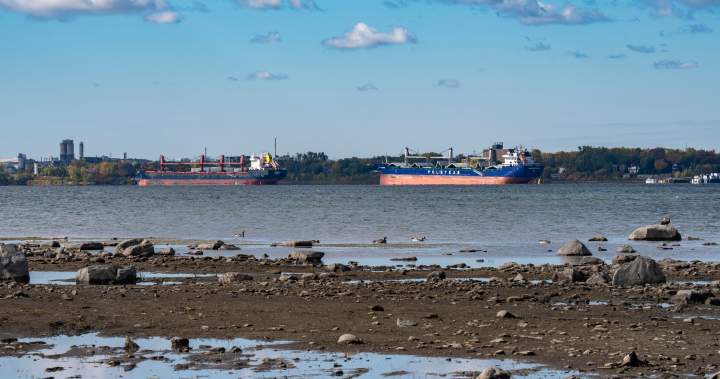Unusually dry weather has pushed the St. Lawrence River to its lowest level in more than a decade, leaving marina owners and shipping operators scrambling to deal with the consequences.
Along Lake Saint-Louis, boats that would normally be floating in the water are now stranded on exposed riverbeds.
Some marina owners say they haven’t seen levels this low in years.
“The water levels we have right now — it’s the level we usually have in July,” said one marina operator, Pierre Champoux, co-owner of Marina Île Perrot. “So there is a big problem.”
The shallow water has already caused damage to vessels. In some areas, boaters have hit rocks that are normally well below the surface.
“We had about a dozen cases where boats hit something,” Champoux said. “One customer, it cost them almost $50,000 after hitting a propeller.”
With winter approaching, the challenge is growing. Boats stuck on the riverbed need to be moved before the water freezes. To help, officials are planning a temporary increase in water flow from the Moses-Saunders Dam near Cornwall.

Get breaking National news
For news impacting Canada and around the world, sign up for breaking news alerts delivered directly to you when they happen.
“What has been proposed this year, exceptionally, is to release a little more water so that we can get these boats out on time,” said Jérôme Marty, a water management expert with the International Association for Great Lakes Research (IAGLR).
The dam release will last for 36 hours and increase flow by about 500 cubic metres per second — the equivalent of an Olympic-sized swimming pool every two seconds.
Marty says water level management is a delicate balance. Dams along the St. Lawrence and Great Lakes systems help prevent spring flooding, but dry conditions this fall have created the opposite problem.
Beyond recreational boating, the low water is also affecting the shipping industry. Cargo vessels have had to lighten their loads to avoid scraping the bottom of the seaway, leading to reduced capacity and potential economic fallout.
“The cargos are unable to take a full load,” Marty said. “That means higher transportation costs, and possibly shortages for consumers.”
Experts say the situation underscores the need for cross-border cooperation between Canada and the United States as extreme weather events become more frequent. “Protecting our waterways is a matter of public safety,” Marty added.
For the full story, watch the video above.
© 2025 Global News, a division of Corus Entertainment Inc.
Low water levels on St. Lawrence River causing problems for marinas, shipping industry





